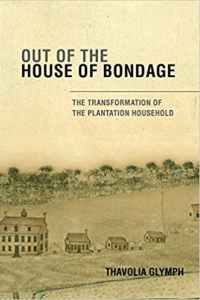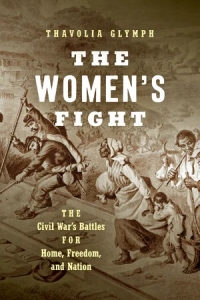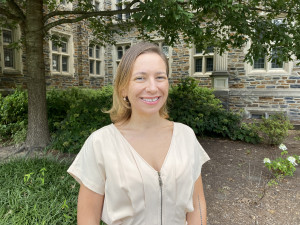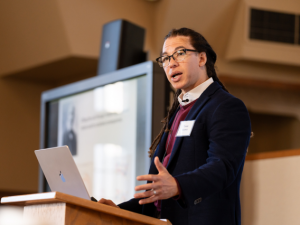Six Awards Confirm the Impact of Thavolia Glymph’s Research

Editor's Note: October 19, 2021
Since this article was first published on May 26, 2021, Glymph received two additional awards for The Women's Fight, both from the American Historical Association: the Albert J. Beveridge Award, given annually to "a distinguished book in English on the history of the United States, Latin America or Canada," and the Joan Kelly Memorial Prize, awarded annually to "the book in women’s history and/or feminist theory that best reflects the high intellectual and scholarly ideals exemplified by the life and work of Joan Kelly."
Editor's Note: November 8, 2021
On November 5, The Women's Fight was awarded the Southern Association for Women Historians' Julia Cherry Spruill Prize, given annually for the best book in southern women’s history. The honor makes eight awards that Glymph has received for the book.
There’s a book that Thavolia Glymph has been working on for a decade. It’s about the experience Black women and children had in Civil War refugee camps, and—through those stories—about what citizenship, freedom and home mean. But the professor of History and Law hasn’t been able to complete it yet because she has focused on other projects.
First came 2008’s Out of the House of Bondage, about the transformation of the plantation household after emancipation. Acclaimed writer Ta-Nehisi Coates called it “essential,” and it was the only book he formally cited in his era-defining work Between the World and Me.
Next came The Women’s Fight, published last year. Exploring the role of women during the Civil War, the book shows the complicated battles that women—Black and white, enslaved and free—took on to define the meaning of freedom, home and nation in the North and South. It’s even more acclaimed.
The Women’s Fight was awarded three prizes from the Organization of American Historians this year—the Civil War and Reconstruction Book Award for the most original book on the coming of the Civil War, the Civil War years or the Era of Reconstruction; the Darlene Clark Hine Award for best book on African American women’s and gender history and the Mary Nickliss Prize for "most original" book in U.S. women's and gender history—along with the John Nau Prize for best book on the American Civil War era and the Society of Civil War Historians’ Tom Watson Brown Book Award.
In recognition of her career impact, last month Duke University also named Glymph a distinguished professor, the highest honor the university can give a faculty member. Beginning July 1, she will be the Peabody Family Distinguished Professor of History.
Now, at last, she can turn her attention back the refugee camps she’s been researching for so long.
Listening to the archive
The book will form a kind of trilogy with Glymph’s others. “The questions of freedom and home have been central to my work as a scholar,” she says. In answering them, she has complicated familiar narratives that define our view of the past.
“Common sense would tell us that women lived not Black lives or white lives or poor lives or rich lives, siloed apart from each other,” she says. “They lived lives that were intermingled, that were connected, that were in contact with each other. I wanted to think about what that meant.”
Out of the House of Bondage was born from a discrepancy Glymph found between the way historians answered that question and the way the people themselves did. “It was not the book I intended to write,” she says. “It grew out of my frustration with the historiography.”
At its core was what Glymph calls the Scarlett O’Hara myth, after the character from the novel and film Gone With the Wind. For decades, existing historiography pictured white plantation mistresses as benevolent, caring matriarchs who loved the enslaved women who worked for them and protected them from the worst evils of slavery. “And that was because they were all women,” Glymph says. The idea was that “there was a kind of sisterhood” grounded in their common gender.
But as Glymph studied archival documents and read the words of enslaved and slaveholding women themselves, she found something very different. “The documents tell me that these women are fighting, that there is a war going on in the antebellum South,” Glymph says. “White women were not these exotic, beautiful creatures who put on ball gowns in the middle of the day and directed, with great love, the enslaved women and children who labor for them.”
Instead, Glymph found evidence that there was great violence among Black and white women in the plantation household, and that the experience shaped the kind of home and labor Black women dreamed of, and fought for, during the Civil War and after emancipation. And it was just those conflicts that came to the fore during the Civil War, as Glymph details in The Women’s Fight.
A new view of the Civil War
During the war, Glymph says, all women were fighting for their homes. But what they imagined those homes to be was very different, wrapped up in opposing ideas of freedom. “White homes, particularly the homes of wealthier white people, meant that the Black home cannot be, if the meaning of home is a place of safety and refuge,” she explains.
While Black women were fighting for emancipation and a chance to build their homes—ones that would look very different from their Southern white counterparts—plantation mistresses were fighting to maintain the freedom to enslave others.
Amidst that conflict were differences between Southern and Northern white women. “I think readers would be surprised by the degree to which Northern white women were unable to divest themselves of their own racism,” Glymph says. When they came to the South during the Civil War—as teachers, missionaries and army support staff—they fought Southern white women’s efforts to help build a pro-slavery nation, but often also against Black women’s autonomy and efforts to build a nation in which they would be accorded equal rights.
By tracing those interconnections and placing women at the center of the tale, Glymph has made a novel contribution to Civil War history. “Traditional Civil War history was not really built to explore the history of Black people,” Glymph says. Largely written by white men, it focused on battles, generals and armies. That has changed in recent decades as scholars have turned their attention to women and the home front, but few books have narrated the era in the way Glymph has. And that fact makes the awards The Women’s Fight has won even more notable, since they span the Civil War era, gender history and Black history.
“To have awards in all three is just tremendous, because it’s saying that the book does do what I intended—it brings these three concerns together in one space,” Glymph says. “I was thrilled and honored that these separate committees saw in the book what they were looking for.”
Understanding refugees and homes
Glymph’s next book on Civil War refugee camps—put off first to correct the historiographical record in Out of the House of Bondage, then because she chose to prioritize The Women’s Fight—will extend the questions of home, freedom and nation to the temporary spaces Black women and children occupied during the war.
“When Black women and children run away to federal lines, what becomes of them?” Glymph asks. “What do they bring with them, in terms of their political consciousness, to try to make freedom in those camps and beyond? I’m interested in the surveillance and management of these camps by federal officials.”
Not only do those questions shape our understanding of the United States and citizenship, Glymph says they have importance implications for how we understand those fleeing war and oppression in this century. “The refugee camps of the Civil War are essential to understanding how we process the notion of refugees today,” she explains. “Who can be a refugee, what does it mean to be a refugee and what kinds of rights does one have?”
When Glymph first began researching the question, the Civil War refugee camps were seldom studied. But that is already changing. “I’m excited that this is now a subject that interests young scholars,” Glymph says, noting that she was recently asked to join a dissertation committee at another university for a student working on the subject. “There is so much work to do, and what I’m doing is just a small piece of it.”
But given the accolades she’s received for her contributions to the subject, even before she’s even written the book, it’s clear her part is an important one.





